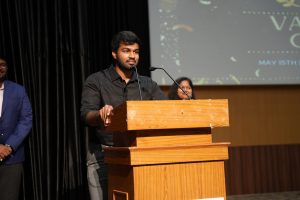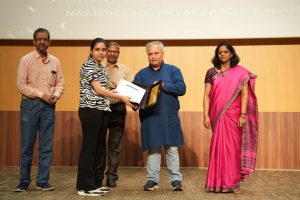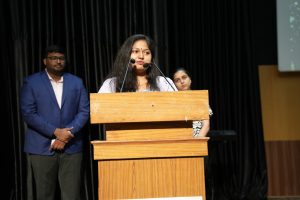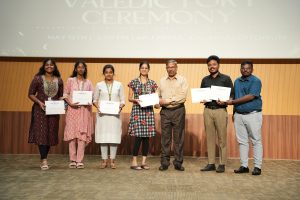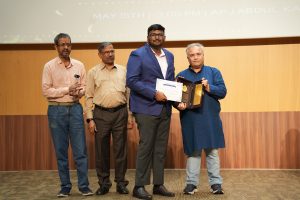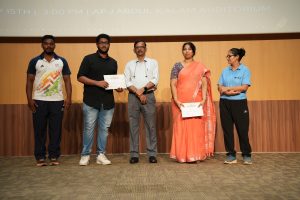All Management Events
- Dr Edukondalu Chappidi May 27, 2024
- Sujith Kalluri May 27, 2024
- Tonmoya Sarmah May 27, 2024
- DEEPS at SRM University-AP organised First Management Development Programme May 27, 2024
Deccan Chronicle
Continue reading →
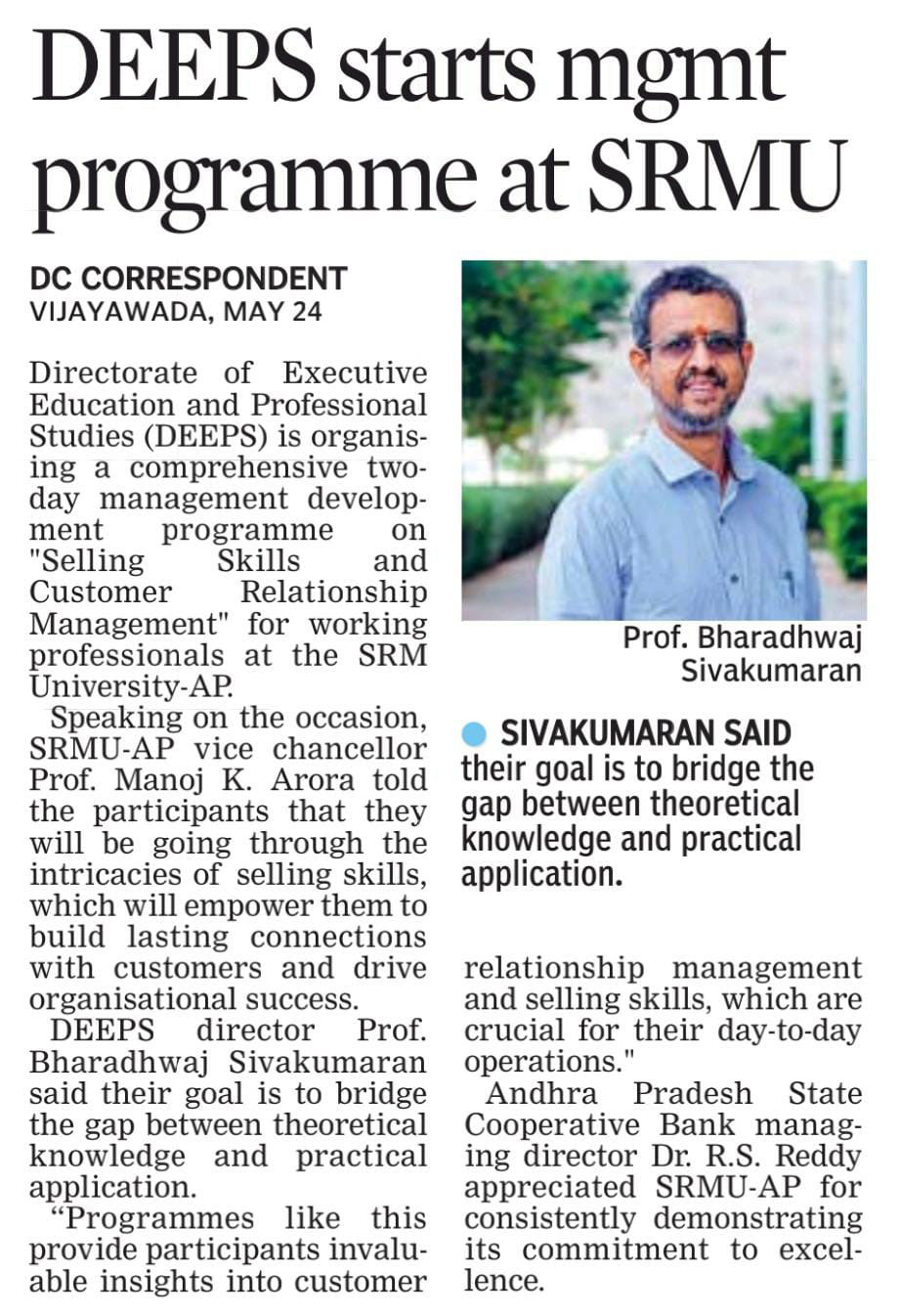
The Hindu
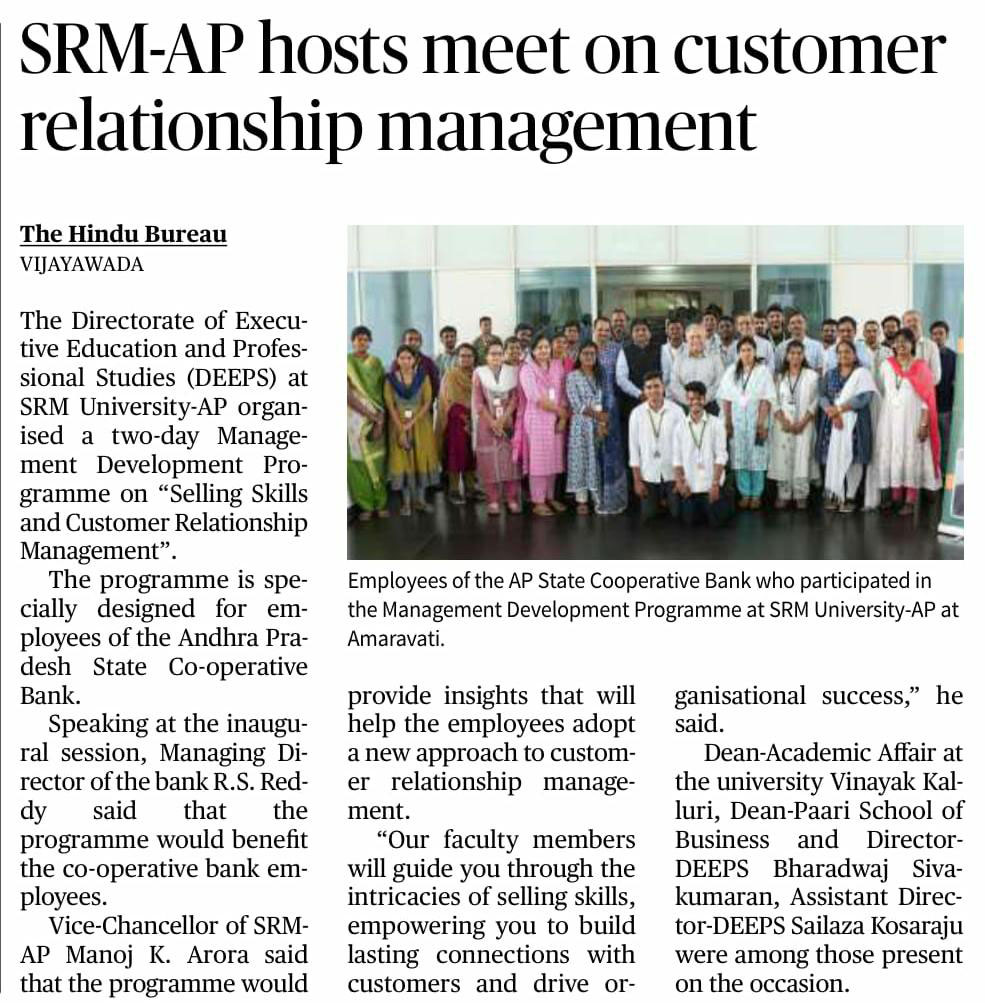
The Pioneer
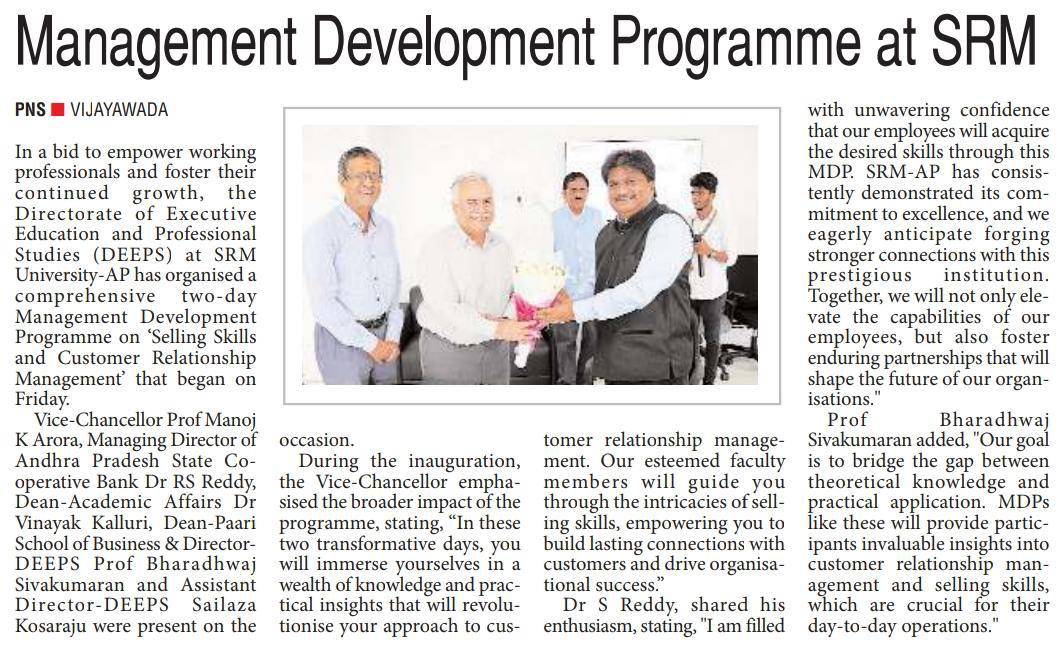
The Hans India
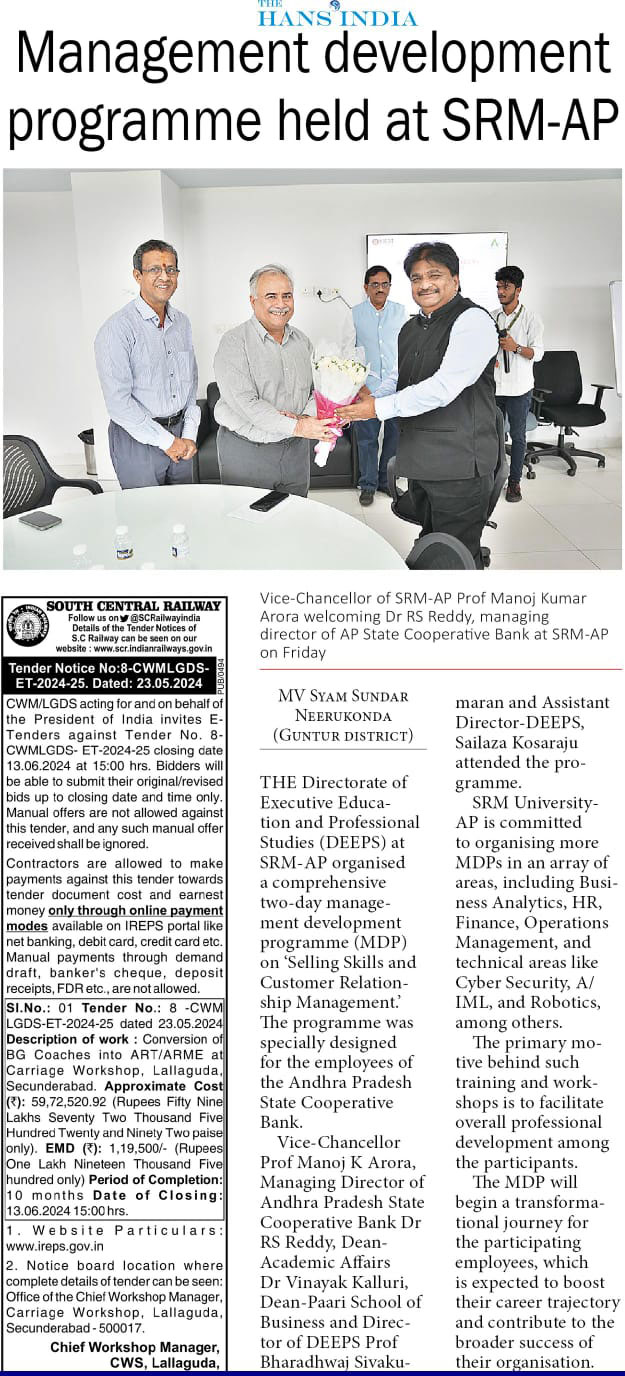
The New Indian Express

Eenadu
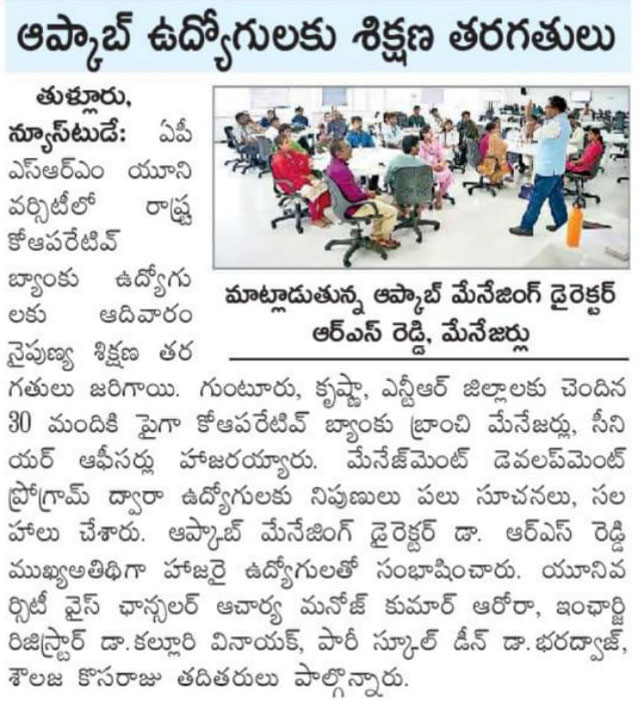
Andhra Prabha
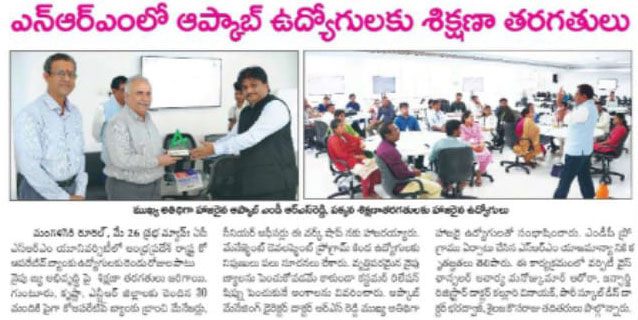
Andhra Patrika
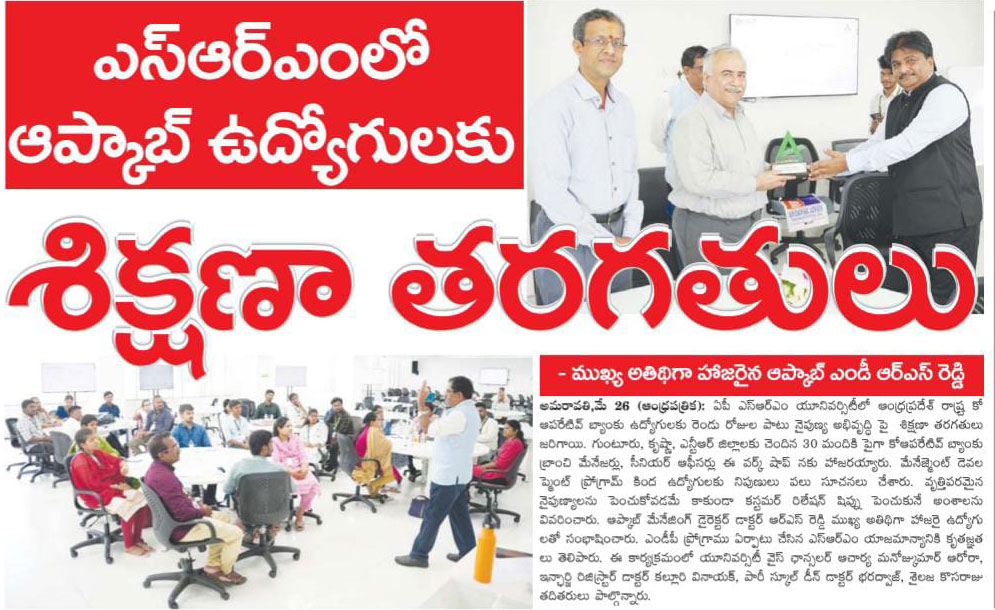
Visalaandhra
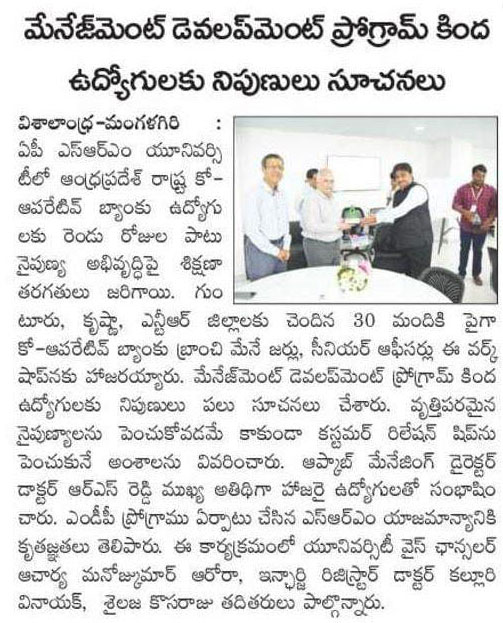
Vartha
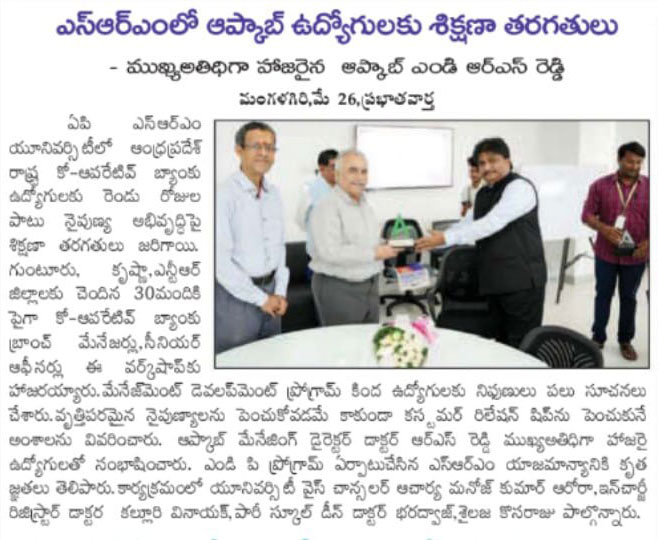
Prajasakthi
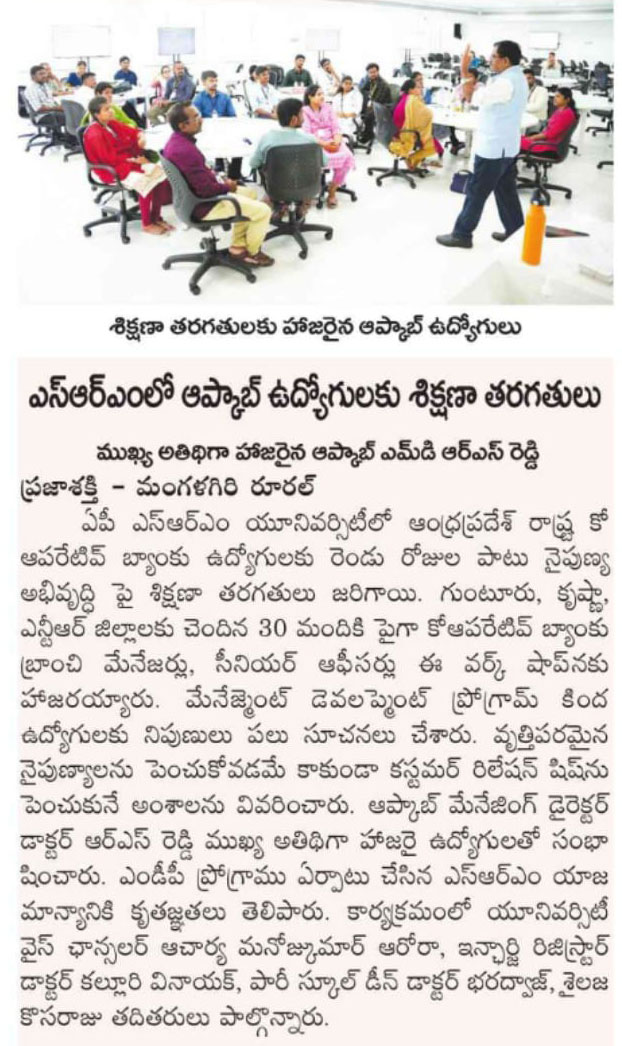
- Dr Krovi Raja Sekhar May 20, 2024
- A New Chapter Begins: Welcoming the Vibrant Leaders of Student Council 2024-25! May 17, 2024
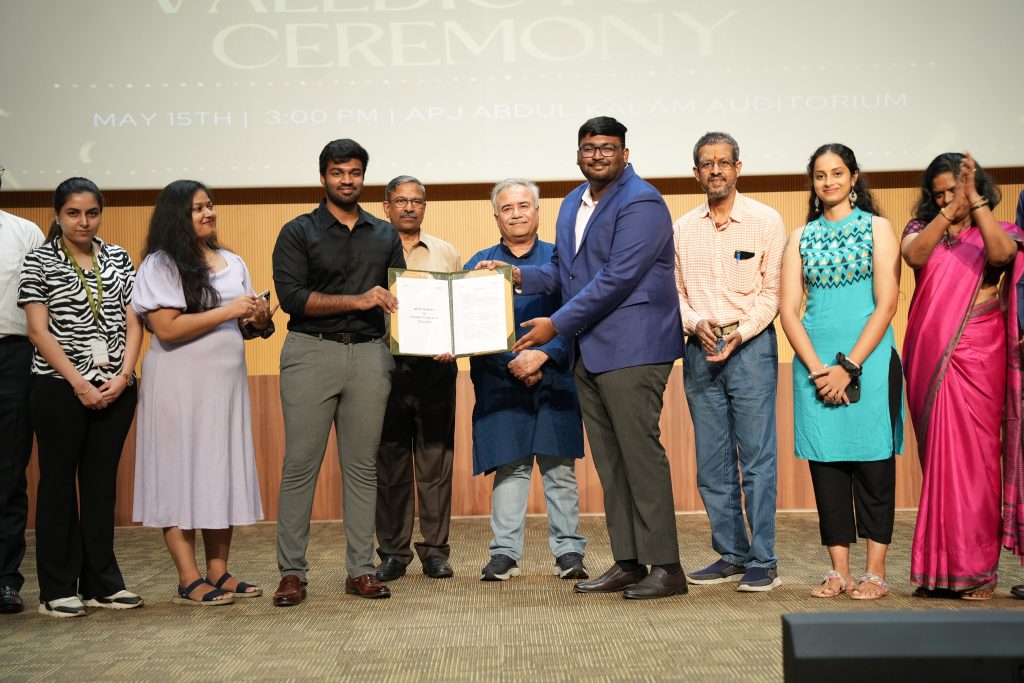
The Directorate of Student Affairs hosted a wonderful Valedictory Ceremony on May 15, 2024, marking a momentous occasion as the university bid farewell to the outgoing Student Council and welcomed the new core team.
The campus bid adieu to Preetam Vallabhaneni, Niruktha Vadlamudi, Sanjana Maini, and Laxman Bankupalle, the charismatic heads of the previous Student Council and applauded them for their phenomenal leadership. Their dedication to managing student needs, organising fests, and ensuring a vibrant campus life has set an incredible standard.
The baton has now been passed to a dynamic new team: Laxman Bankupalle, Nivedha Sriram, Ankith Reddy, and Rishabh Ranjan Ishwar, who will serve as the President, Vice President, General Secretary and Treasurer of Student Council 2024-25. The vibrant team is ready to take the reins and elevate the student experience even further. “With their remarkable capabilities, we are confident that they will continue to strengthen the bridge between the student community and university management”, stated Vice Chancellor Prof. Manoj Arora, as he welcomed the new student leaders. Associate Director-Student Affairs, Ms Revathi B exclaimed, “A new team brings in new energy, a new chapter”, as she perfectly captured the spirit of this transition.
The ceremony also recognised the outstanding contributions of all clubs, societies and committee members, SC members, NSS, CESR (Corporate Engagement and Social Responsibilities), sports teams, and volunteers. The event was graced by the presence of our esteemed Registrar, Dr R Premkumar, CFAO Ms Suma Nulu, Deans, Directors, Faculty and Students of the varsity.
Continue reading → - Mr BVS Lakshman was elected as President of the Student council May 16, 2024
Andhra Patrika
Continue reading →
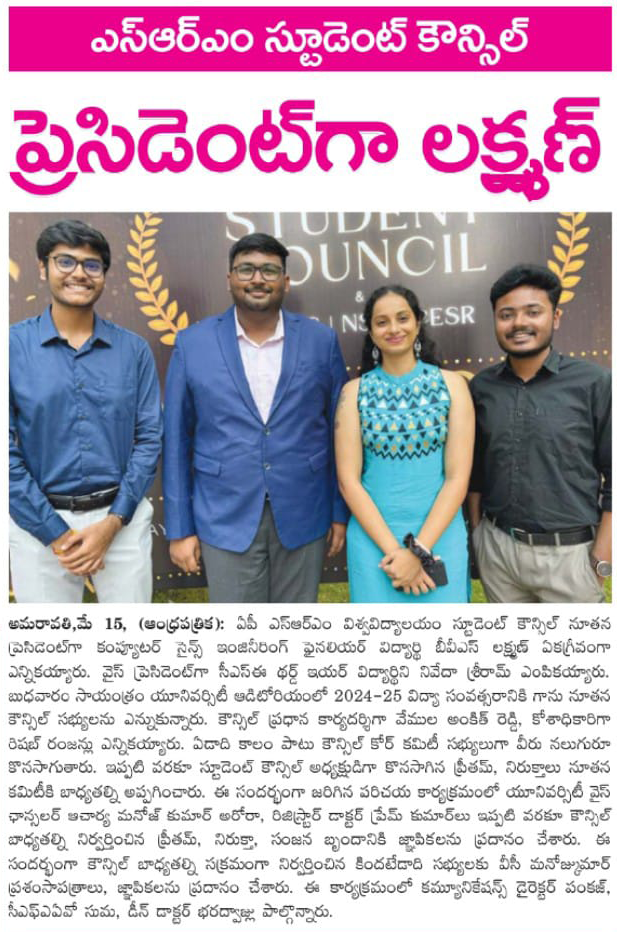
Andhra Prabha
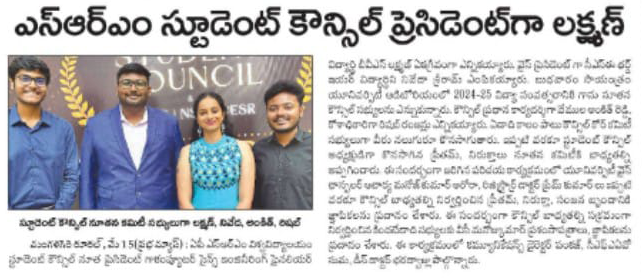
Prajasakthi
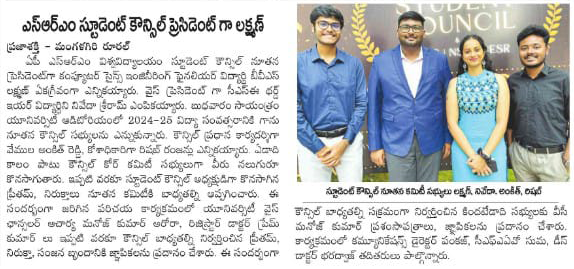
Tehelka Power

Telugu Patrika
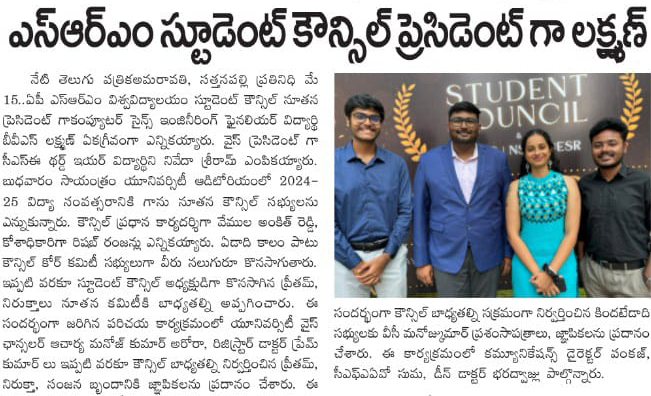
Vartha
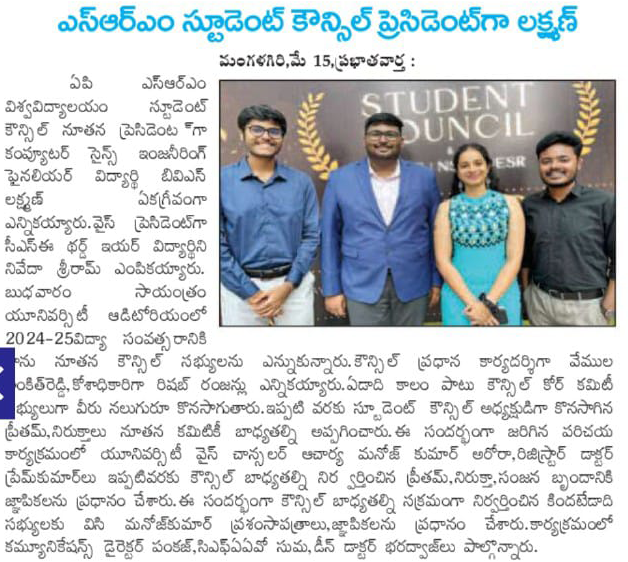
Visalaandhra
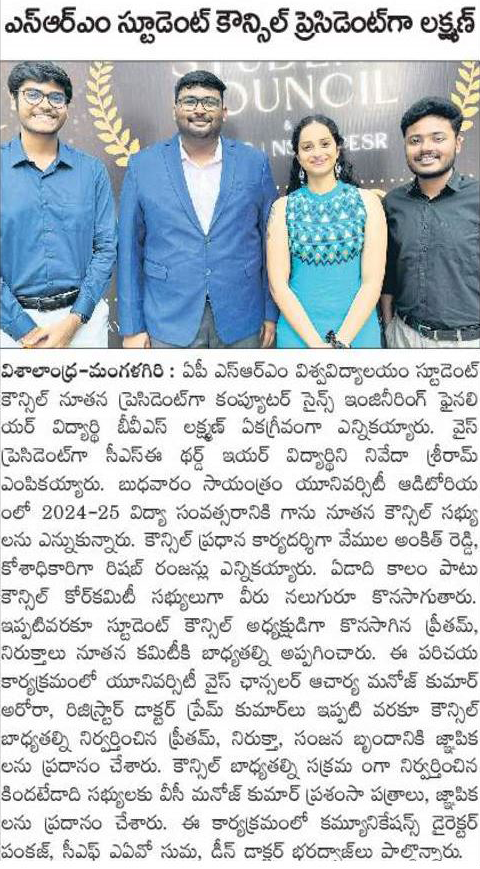
- SRMAP Students, Staff take the Pledge to Cast their Votes May 16, 2024
Times of India
Continue reading →
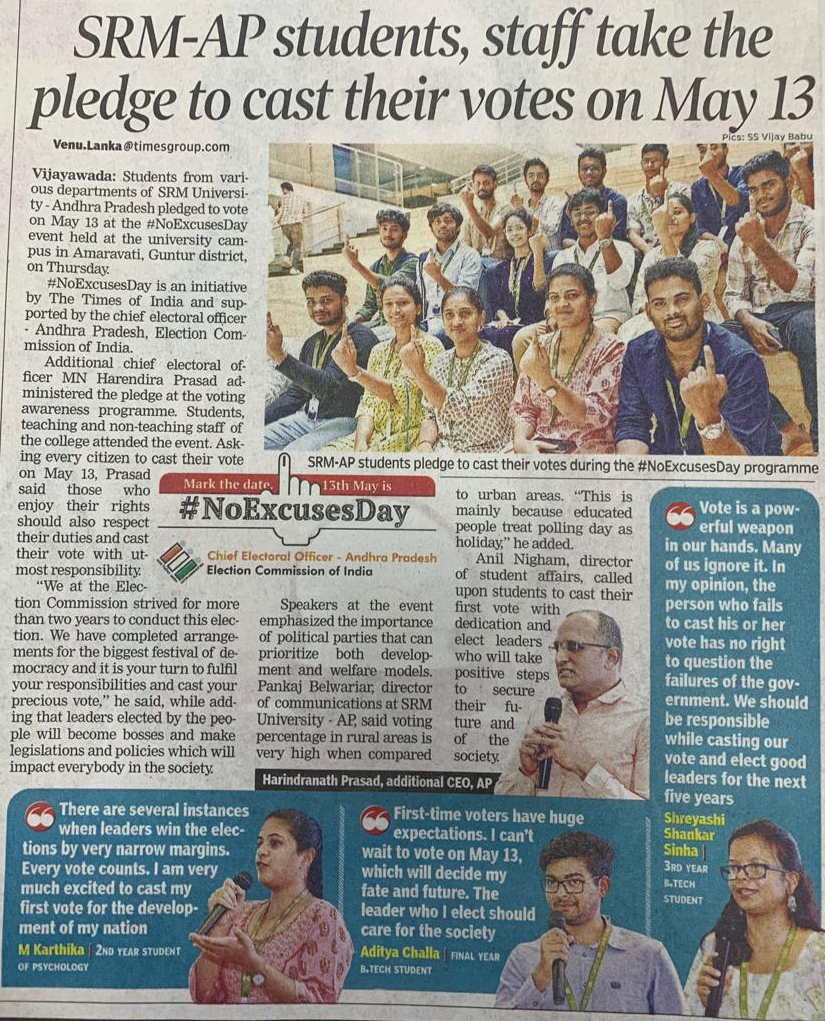
- Skipping Champion Awarded Silver at South Asian Championship May 16, 2024
Eenadu
Continue reading →
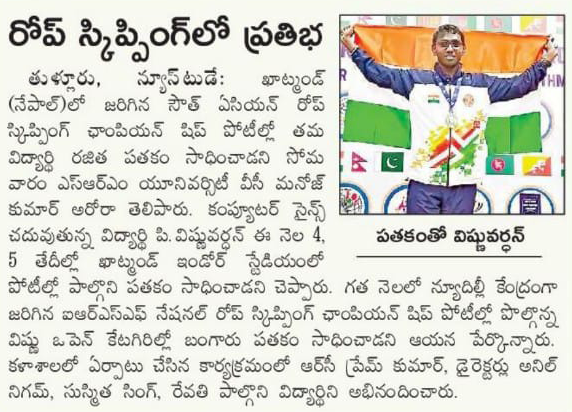
Andhra Prabha
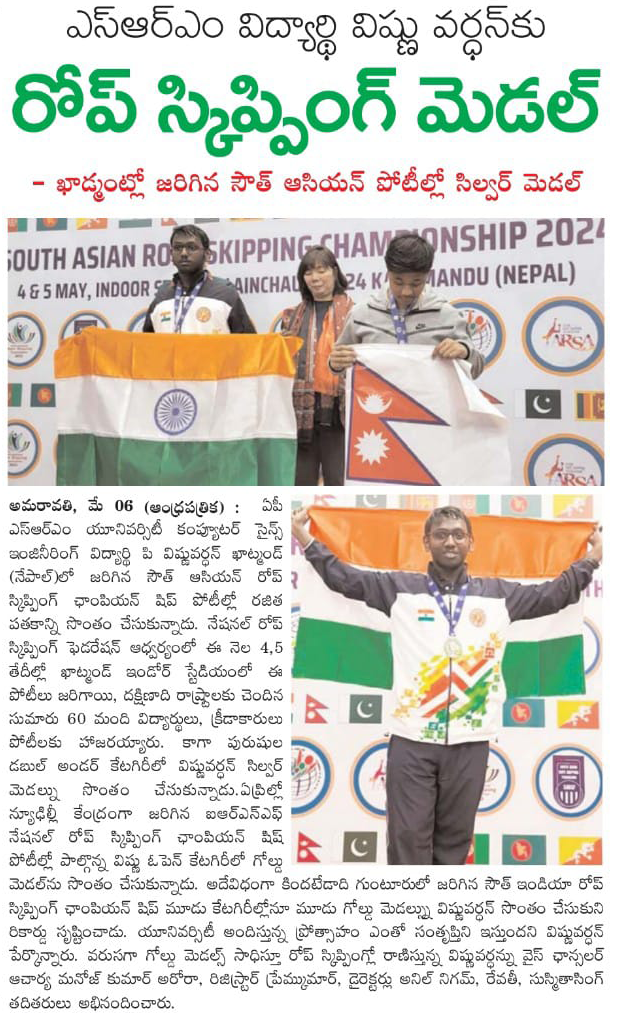
Andhra Patrika
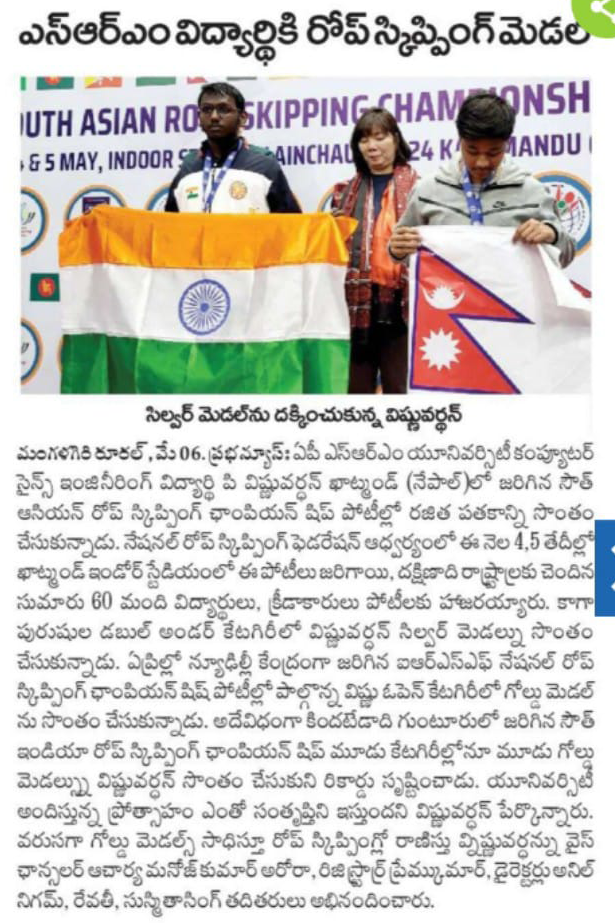
Tehelka Power

- Innovative Wind Turbine System Patent Awarded to Dr Goutam Rana and Team May 16, 2024
 In a significant advancement for sustainable energy technology, the Indian Patent Office Journal has officially granted a patent for the “Mini magnetically levitated wind turbine system for power generation.” This groundbreaking invention, bearing Application Number: 202241051560, is the brainchild of Dr Goutam Rana, Assistant Professor in the Department of Electronics and Communication Engineering.
In a significant advancement for sustainable energy technology, the Indian Patent Office Journal has officially granted a patent for the “Mini magnetically levitated wind turbine system for power generation.” This groundbreaking invention, bearing Application Number: 202241051560, is the brainchild of Dr Goutam Rana, Assistant Professor in the Department of Electronics and Communication Engineering.Dr Rana, along with his dedicated team of B. Tech ECE students—Mr Vybagula Sai Vamsi, Mr Moparthi Teja, Mr Indrakanty Satwik, and Mr Pidikiti Venkata Abhinash have developed a system that promises to revolutionise how we harness wind energy. The turbine’s miniaturised and magnetically levitated design allows for efficient power generation with minimal mechanical friction, leading to a longer lifespan and reduced maintenance costs.
The team’s innovation aligns with global efforts to transition to renewable energy sources and showcases the potential of academic research in contributing to real-world challenges. The patent grant not only recognises the technical ingenuity of the invention but also underscores the collaborative spirit of the students and faculty at the institution.Abstract:
Due to the increasing demand and supply gap, in the electrical energy system, wind energy is coming out as an alternative form of clean-with zero-carbon footprint renewable energy sources for power generation. The same is true for hydrocarbon-based fuels whose resources are limited and the contribution of vehicular pollution is also raising concerns in every-degrading the air quality index (AQI) of Indian cities. The electric and hybrid vehicles thus emerging fast as an alternative but often being hindered by the unavailability of proper charging infrastructures on roads.
The current invention is aimed to enable the use of wind turbines for harnessing wind energy and utilize the same to charge batteries of electrical vehicles or hybrid vehicles. The major challenges that have prevented the use so far are mainly two viz. low air flow and larger air drag. To address low airflow in normal road conditions in congested city alleys, we demonstrated the use of magnetically levitated Vertical-axis turbines instead of conventional ball-baring-based Horizontal-axis wind turbines. To reduce the air drag the use of vertical axis magnetically levitated wind turbines is a good option since the air drag experienced in the blade unit is not exactly in contact with the car body.
To improve on the drag further we have introduced an array of mini turbine units instead of one big unit which helps in distributing the total drag over a large area and since air can pass easily through small units overall drag experienced will be small. Also, to keep the levitation small, the rotating unit is made lighter with 3D printing perforated PLA material.
The rest of the operation of the system is similar to any wind turbine system i.e. with the help of permanent magnet and coil arrangement we will convert the wind energy (rotor movement) into electrical energy (e.m.f.). Only here instead of one single source, we will generate multiple small sources of induced electrical energy which can then be coupled together and used for charging the battery.Since the invention uses magnetic levitation, friction is minimal. This helps the rotor to become independent of natural wind flow and use the movement of the vehicle to generate the required torque for the rotor movement. Our invention can be installed in the rooftop space of any vehicle and since it is divided into an array of smaller units, allows the optimum use of available space of the used vehicle. Overall cost and weight are also very minimal. Here, the most practical use case can be the widespread E-rickshaws in India. The choice of the use case is based on the fact of their large presence, longer run hours, and limited speed for the runs.
Explanation of the Invention in Layperson’s Terms:
The invention will act as a source of energy and can be used to charge batteries of electric vehicles or hybrid vehicles. The device converts wind energy to electrical energy through mini wind turbine arrays which can be placed on top of the rooftop of the vehicles. The rotor is kept suspended from the stator unit using magnets to eliminate friction. This helps to operate the device without the presence of strong natural wind, it utilizes the movement of the vehicle to generate the necessary rotation. The mini turbine arrays and magnetic suspension help to reduce the effect of wind drag (extra wind replaced by the turbine unit).Practical Implementation or the Social Implications Associated
The invention is intended to solve a few on-road challenges of Electric Vehicles (EVs). The current invention is:
1. Low cost and one-time investment with zero maintenance charge for an EV
2. The proposed device can act as a secondary power source for the vehicle
3. The proposed device will convert wind energy, thus completely environment-friendly, and with comes with absolutely zero carbon footprint
4. The proposed device can add some extra mileage to the current battery storage as much as it runs.
5. With other renewable sources together a hybrid vehicle can be built which is free of fossil fuel completely.Future Research Plans:
The current invention is in just proof of concept stage. We are currently working on the following
Continue reading →
1. to improve the overall efficacy of the device such that each unit can harness wind energy to its optimal potential. With this, we will try to ensure that the battery gets charged completely (or at least a significant percentage) during each run during the day.
2. We are also working on the numerical study to calculate the actual wind drag with a more optimal design so that we can estimate how many units a certain vehicle will require and what should be the optimal placement scheme to utilize the maximum wind effect.


